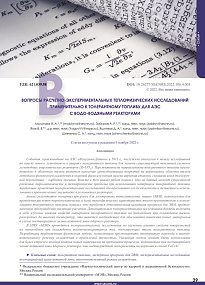Approaches to the thermophysical justification of the applicability of accident tolerant fuel for nuclear power plants.
Molotova I. A., Zabirov A. R., Yagov V. V., Yashnikov D. A., Shevchenko S. A.
The events at the Fukushima Daiichi nuclear power plant in 2011 were the beginning of the researches to find new fuel which is accident tolerant to replace the existing fuel system for light water reactors (Zr-UO2). Promising areas of the accident tolerant fuel in relation to a fuel rod cladding are the deposition of chromium-containing coatings on zirconium fuel rod cladding by physical vapor deposition methods or the complete replacement of zirconium with steels, alloys or silicon carbide in the long term. At the same time, the analysis showed that there are various thermomechanical and thermophysical problems for using accident tolerant fuel materials. It requires experimental studies to justify safety and further using of these materials on an industrial scale in light water reactors.
An analysis of expertise of computer codes used to calculate the thermomechanical and/or thermophysical characteristics of fuel rods in relation to accident tolerant fuel showed that their additional validation is required. Additional experiments should investigate the influence of accident tolerant fuel material properties on heat transfer during cooling of high-temperature fuel rods, which is necessary to justify the behavior of new materials in the event of core reflooding.
Experiments to study the influence of surface properties on heat transfer during cooling of high-temperature bodies simulating fuel rods of accident tolerant fuel are carried out at NRU “MPEI”. An approximate physical model has been developed to predict the transition temperature to a high-intensity cooling regime with acceptable accuracy. Experimental results confirm that this model can be used for a more rigorous analysis of the effect of new materials (chromium-containing coatings on zirconium, FeCrAl) during core reflooding.
Keywords: accident tolerant fuel, expertise of computer codes, experimental studies, core reflooding, high-intensity cooling regime.
Article language: Russian. Pp. 29–70. DOI: 10.26277/SECNRS.2022.106.4.003.
Approaches to the thermophysical justification of the applicability of accident tolerant fuel for nuclear power plants
Authors:
Molotova I. A. , Zabirov A. R. , Yagov V. V. , Yashnikov D. A. , Shevchenko S. A.
Issue:
4 (106) – 2022.


